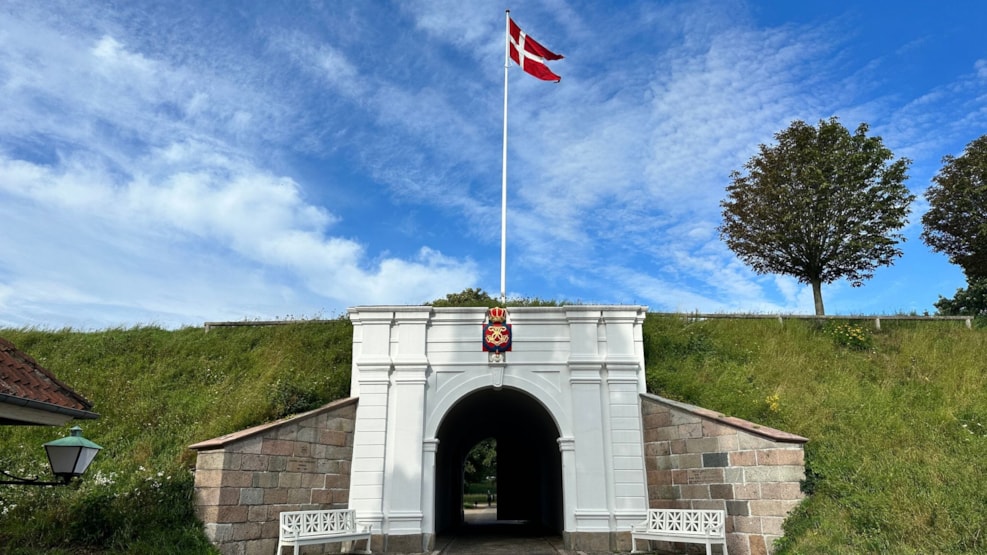
An Outline for the Fortress
Fredericia was built on a bare field. A desolate place where no city should be built. However, the area made good military sense.
After Jutland had been occupied, plundered, and burned during the period from 1626-29 and again in 1643-45, it became clear that Jutland needed a defense, including a strong fortress. The area near Bersodde was ideal, even though large parts were untouched marshland. The peninsula was bordered by water on two sides, allowing the military to fortify the city with relatively few kilometers of ramparts and to transport supplies and troops in and out of the fortress via the sea route.
King Frederick 3. initiated the construction work in 1650. The plans were grand. The style drew on the ideas of the time, where the Renaissance was fading to make way for the Baroque. Here, the king stood resplendent at the center of a swelling and monumental presentation. The initial plans were infused with pride, power, and grandeur. The city was to have a harbor and canals through which goods, supplies, and troops could be transported directly into the heart of the fortress. The city was to accommodate both the King’s and Queen’s Squares, a castle moat, and a royal castle, as well as a stock exchange and several other prestigious buildings.
However, the ambitious plans for construction and canals were never realized. But the fortress was established with mathematical precision and long straight streets.
It took years to build the ramparts, even though the workforce numbered 5,000 men. But before they were completely finished with the ramparts, the Swedes attacked Denmark again. The fortress was captured through an unfinished section of the ramparts, and the city was ravaged. So, when the Swedes withdrew in 1660, work began anew on the ramparts.
A city populated by soldiers, rogues, murderers, and believers from all over Europe
At that time, the idea was that a fortress should have a city as its foundation to function—trade and craftsmanship were to supply raw materials, food, and manufactured goods—the citizens provided labor and accommodation for the soldiers—and could also contribute as a reserve force through citizen militias. But no one wanted to live there. What to do? The king forcibly disbanded the nearest villages and relocated the inhabitants to the city. It still wasn't enough. So, the king granted the city special privileges such as free land for building, additional land outside the city, and ten years of tax exemption. For a time, the monarchy considered dismantling the nearby cities Kolding and Vejle and relocating the citizens to Fredericia. However, this was abandoned, and instead, criminals were allowed to settle in the city by granting them asylum. This attracted debtors and murderers. Additionally, various religious groups were granted freedom of worship within the city walls, which the Huguenots, Catholics, and Jews accepted. This diversity left its mark on the city well into the 20th century.
Defeated, besieged, abandoned
The fortress was directly involved in three wars.
In 1657, when the Swedes used an unfinished rampart as a backdoor for a flank attack and won.
During the First Schleswig War, when the fortress withstood a two-month siege. Here, the Danish generals acted against prevailing conventional military logic. On July 6, at one in the morning, they launched a surprise attack on the Schleswig-Holstein troops and won—even though they were only about half the number of soldiers believed necessary to defeat the opponent.
Finally, the fortress was besieged again during the Second Schleswig War but was evacuated following the defeat at Dybbøl in 1864 to the Prussian army.
Legacy
After the war in 1864, the fortress quickly lost its military significance. And in 1909, the military abandoned the fortress. Fortunately, Fredericia Municipality purchased the fortress structure as early as 1914. By 1917, the structure was protected. Thus, posterity secured one of Europe’s best-preserved fortress structures, which today lies as a green circle around the city center. Here, you can enjoy history and nature via over 18 km of green paths.
You can also listen to the history in the form of a podwalk: "The Witnesses of the Ramparts" – find it on the Useeum app – or try the podcast "Fredericia City and Fortress," which in 12 short episodes tells the story of the fortress and the city. It’s free, and you can find it wherever you normally get your podcasts. You can choose to listen to "The Witnesses of the Ramparts" or "Fredericia City and Fortress" in Danish or English.